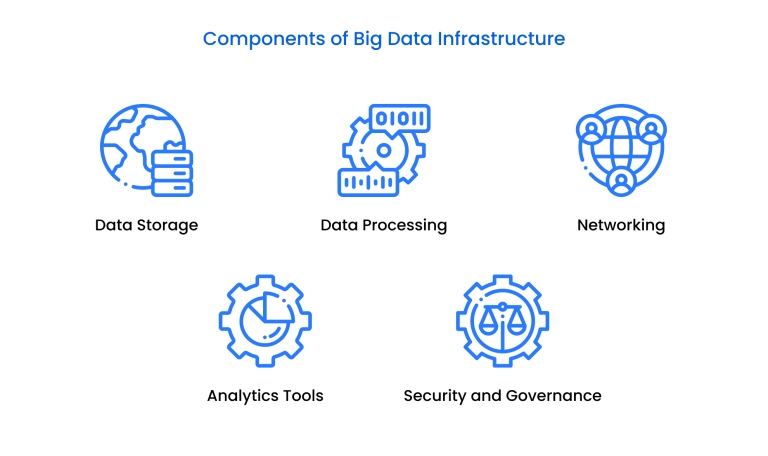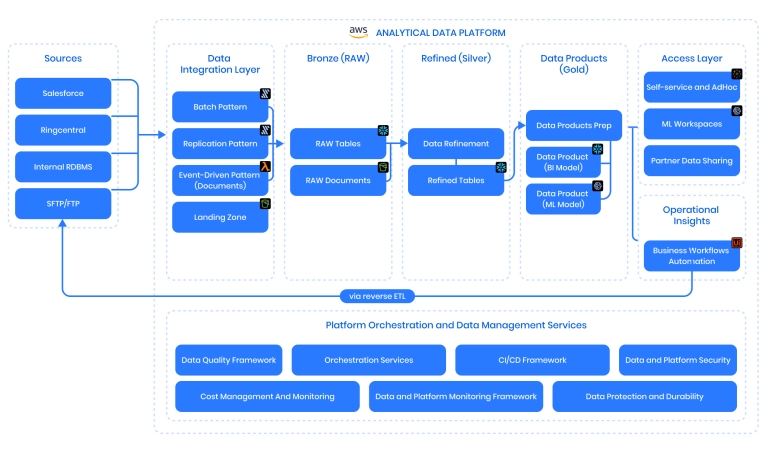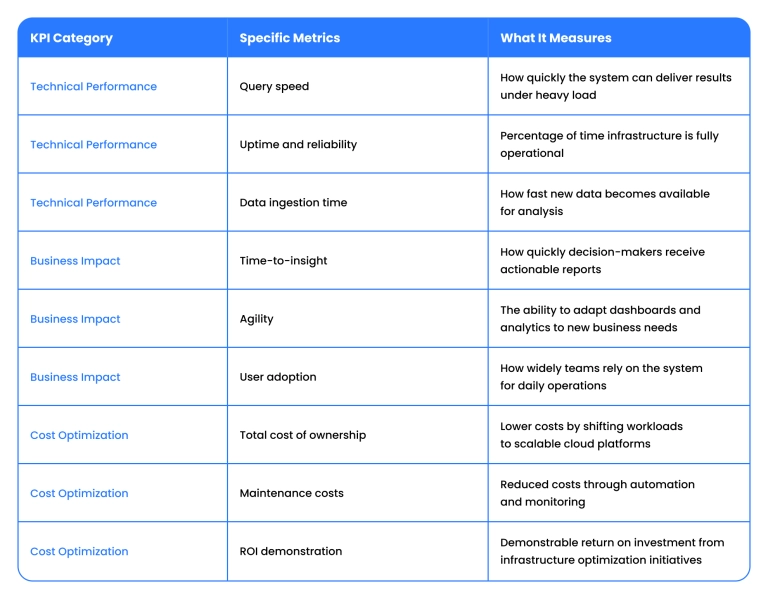Modern enterprises run on data, yet too many still operate with outdated data infrastructure that slows them down. In 2025, modernization is a defining factor for competitiveness – and the cost of inaction is steep.
Every day, businesses lose millions in productivity waiting for slow reports, struggling with data silos, and making decisions on outdated information. While headlines focus on AI investments , the real competitive advantage lies in fixing the foundational data infrastructure that makes AI possible.
In this article, you will explore:
- What data infrastructure is and why it matters
- How to spot data infrastructure challenges and bottlenecks
- Strategies to optimize data infrastructure for performance and scale
- Real-world case study and industry applications
If your organization is dealing with sluggish queries, delayed reports, or spiraling maintenance costs, this guide will show you how to turn bottlenecks into measurable business outcomes.
What is data infrastructure?
At its core, data infrastructure is the foundation that allows organizations to collect, store, process, and analyze information at scale. It includes hardware like servers and storage, software such as databases and analytics platforms, and the cloud or hybrid environments where data flows.
Without a reliable infrastructure, companies struggle to extract value from their information, making it a critical enabler of modern business strategy.
Key components of data infrastructure

The main elements include:
- Storage and databases for structured and unstructured data;
- Processing frameworks that transform raw information into usable insights;
- Integration tools to connect multiple data sources;
- Security and governance mechanisms that ensure compliance and trust.
Database infrastructure vs. data infrastructure
While database infrastructure focuses specifically on systems for storing and querying data, data infrastructure is broader. It encompasses databases and the pipelines, modeling practices, and analytics tools needed to turn information into actionable intelligence.
For instance, optimizing data infrastructure in healthcare requires more than database tuning; it often involves rethinking architecture, introducing cloud-native platforms, and ensuring compliance with strict regulations.
When data infrastructure limits success
Recognizing when data systems are holding a business back is critical. Slow queries, dashboards that lag, and analytics pipelines that can't scale are the first signals that data infrastructure optimization is overdue. What begins as minor delays often expands into missed insights, higher costs, and reduced competitiveness.
As volumes grow, outdated setups force IT teams into constant maintenance while executives wait longer for reliable reports.
These delays in sectors like healthcare or finance translate directly into lost opportunities and operational risks. Among the most effective ways to improve IT infrastructure are redesigning pipelines, modernizing data models, and adopting scalable cloud platforms – steps that transform bottlenecks into a foundation for growth.
Common challenges and bottlenecks
The most frequent data infrastructure challenges include:
- Performance indicators – slow queries, lags in dashboards, and delays in analytics pipelines.
- Business impact – reporting cycles that take too long, leading to lost opportunities and slower decision-making.
- Financial cost – escalating expenses from maintaining outdated systems and inefficient processes.
Impact on data analytics and business outcomes
These issues translate into real business risks with measurable consequences. The case of a prominent healthcare provider specializing in in-home care across the US exemplifies this challenge perfectly. Our client's data infrastructure had become a critical bottleneck, threatening care quality.
Delays in accessing patient information and risks of data mismanagement directly impacted their ability to deliver quality in-home care services.
The solution required comprehensive modernization, ultimately delivering 50% faster data ingestion and a 75% improvement in decision-making speed – demonstrating how addressing infrastructure bottlenecks directly translates into operational excellence.
Ready for data transformation? Binariks' specialists deliver proven results
Infrastructure assessment and modernization strategy
A clear modernization roadmap starts with assessing the current setup, identifying bottlenecks, and aligning upgrades with long-term business objectives. Without this groundwork, companies risk fragmented fixes that solve symptoms but not root causes.
Principles of data infrastructure design
A solid data infrastructure strategy begins with mapping how data is generated, stored, and consumed across the organization.
In our healthcare project, this meant tracing patient data from initial intake through caregiver mobile apps to final reporting dashboards. This comprehensive review revealed that legacy models weren't just slow – they forced analysts to duplicate efforts across multiple systems, creating inefficiencies that compounded at scale.
Technological stack (SQL/NoSQL, cloud vs. on-premise)
The right mix of tools drives data infrastructure modernization . SQL systems still anchor structured workloads, while NoSQL supports unstructured data such as caregiver notes.
For a healthcare provider managing massive patient datasets, we recommended Snowflake as the core warehouse platform, integrated with Tableau for visualization and DBT for transformation workflows. This shift improved scalability, reduced maintenance, and gave analysts a unified platform for data visualization.
Migration planning (minimizing risks and downtime)
Successful migration requires maintaining business continuity throughout the transition.
To optimize data infrastructure, migration must avoid service disruption. Binariks executed a phased rollout: legacy dashboards were remodeled step by step, pipelines were rebuilt with DBT, and validation was done with test frameworks before go-live.
This approach kept analysts productive during the transition while ensuring accuracy and continuity.
Risk mitigation (security, compliance)
Modernization must respect industry regulations. Strong data infrastructure architecture enforces governance, especially in healthcare, where HIPAA compliance is non-negotiable.
In our implementation, automated testing with Great Expectations provided continuous data integrity validation, while AWS-native security controls ensured HIPAA compliance across all environments.
Building a future-ready data infrastructure
Sustainability requires adaptability. AI-ready pipelines and scalable warehouses are now standard.
By studying data infrastructure examples across industries, Binariks designed a dual-layer architecture for the client: a data lake for raw intake and a warehouse modeled with Kimball methodology for analytics. This allowed the healthcare provider to handle growing volumes without hitting bottlenecks again.
Implementation roadmap: From analysis to optimization
Modernizing infrastructure isn't a single upgrade – it's a structured process that turns fragmented systems into a scalable foundation. The roadmap typically spans design assessment, migration planning, technology adoption, and performance monitoring.
Ways to optimize IT and data infrastructure
The most effective methods for building data infrastructure include redesigning pipelines, modernizing data models, and restructuring warehouses. Incremental rollouts, rather than full cutovers, minimize disruption and ensure continuity. Tools like DBT and Terraform are commonly deployed to standardize workflows and automate testing.
Emerging data infrastructure technologies
Cloud-native platforms and AI-ready pipelines now define modern data infrastructure architecture . Solutions like Snowflake, Redshift, and Databricks allow seamless scaling, while frameworks such as Great Expectations ensure real-time monitoring and governance. Edge computing and hybrid environments are also becoming critical for organizations balancing performance with compliance.
Architecture to execution
- Data infrastructure design principles
Effective database infrastructure design starts with the end user. Dashboards, APIs, and applications should receive consistent, validated data that's modeled for usability. This requires dual-layer approaches: data lakes for raw storage and warehouses for structured reporting. Following methodologies like Kimball ensures maintainability while supporting analytics and machine learning workloads.
- Data modeling improvements
Legacy systems often fail because they're built on outdated logic. Modern data infrastructure design involves remodeling to eliminate redundancy, improve query speed, and reduce costs. For healthcare providers, optimized data models mean caregivers and analysts can access real-time information, supporting clinical and operational decisions.
- Warehouse restructuring
Data warehouses must evolve as volumes grow. Modern restructuring aligns storage with business use cases, combining analytics-optimized tables with compliance-ready audit logs. This is where choosing a strong data infrastructure modernization partner matters: external expertise accelerates the process while avoiding costly mistakes.
Binariks' case study: Healthcare data infrastructure transformation
For any healthcare organization, strong data infrastructure and analytics are essential to ensure information flows quickly and accurately from patients to decision-makers.
A great demonstration of successful modernization comes from our work with a prominent healthcare provider headquartered in New York, specializing in comprehensive in-home care services across the US.
When we first engaged, their existing infrastructure struggled with overwhelming volumes of patient health records, caregiver credentials, and treatment logs. These bottlenecks created delays in accessing patient information and compromised operational performance – directly impacting care quality and scalability.
How we approached the challenge:
We conducted a comprehensive assessment of their Snowflake and Tableau systems, gathering data via API for complete asset inventory. Through multiple POCs, we identified optimization opportunities aligned with their specific needs and budget.
Using Terraform, we established standardized AWS infrastructure with dual-layer architecture: a data lake for raw data storage and a Kimball-methodology warehouse for structured reporting.
We deployed DBT for data transformation, migrated legacy dashboards, and implemented Great Expectations for automated testing with Elementary for real-time monitoring.

Results and impact:
The transformation delivered: 50% faster data ingestion, significant cost savings through automation, and 75% improvement in decision-making speed.
The scalable architecture now supports seamless integration of new data sources while enabling stronger partner collaboration through streamlined reporting systems.
Measuring success: KPIs for data infrastructure performance
The effectiveness of modern data analytics infrastructure is measured through well-defined KPIs that capture both technical and business outcomes:

For organizations seeking expert guidance, leveraging big data analytics services can accelerate progress by ensuring KPIs are defined and systematically achieved through proven frameworks. These metrics also highlight the most effective ways to improve IT infrastructure, ensuring it performs technically while delivering measurable business value.
Examples of data infrastructure in industry applications
Modernization impacts nearly every sector, and clear data infrastructure examples show how transformation delivers value:
- Finance: Banks rely on resilient data management infrastructure to handle transactions securely and support real-time fraud detection. Speed and compliance are key to maintaining trust.
- Healthcare: Providers must balance compliance with scalability. Modern data infrastructure technologies enable secure patient record handling, predictive analytics, and improved outcomes. See our take on the challenges of big data in healthcare for more context.
- E-commerce: Retailers use advanced pipelines to personalize recommendations, manage supply chains, and predict demand. This answers the question of what a data infrastructure is in a consumer-driven environment – a system that enables immediate insight from customer behavior.
- Manufacturing: IoT integration and predictive maintenance depend on modern warehouses and pipelines that connect sensors to analytics platforms, preventing costly downtime.
Final thoughts
Enterprises that continue to rely on legacy data infrastructure face growing risks: slower decisions, higher costs, and missed opportunities in markets that reward speed. Modernization is not merely about upgrading tools; it involves establishing an agile foundation for analytics, artificial intelligence, and long-term scalability.
As a data infrastructure modernization firm, we at Binariks help companies move from bottlenecks to measurable success.
Our expertise spans end-to-end assessments, architecture design, cloud migration, and advanced analytics solutions. Whether the goal is faster reporting, cost efficiency, or regulatory compliance, we deliver tailored strategies and execution that turn data into a competitive asset.
Share

